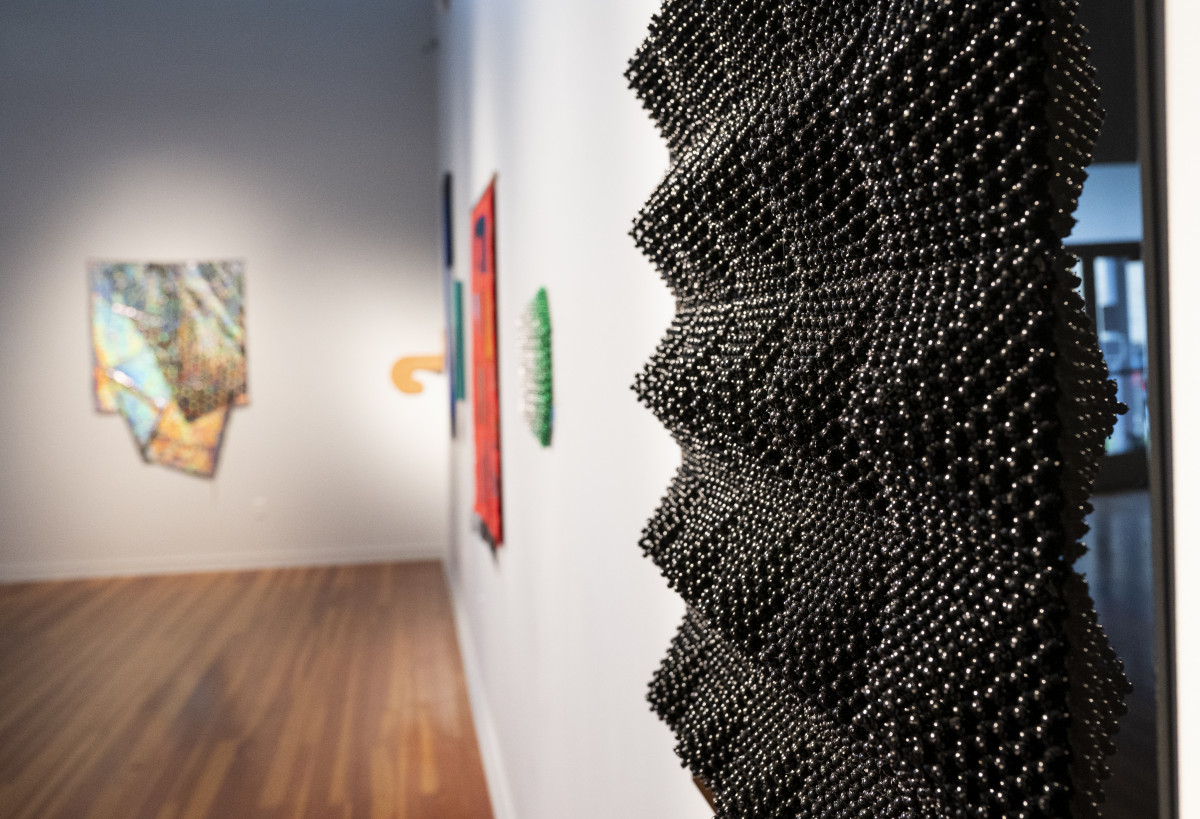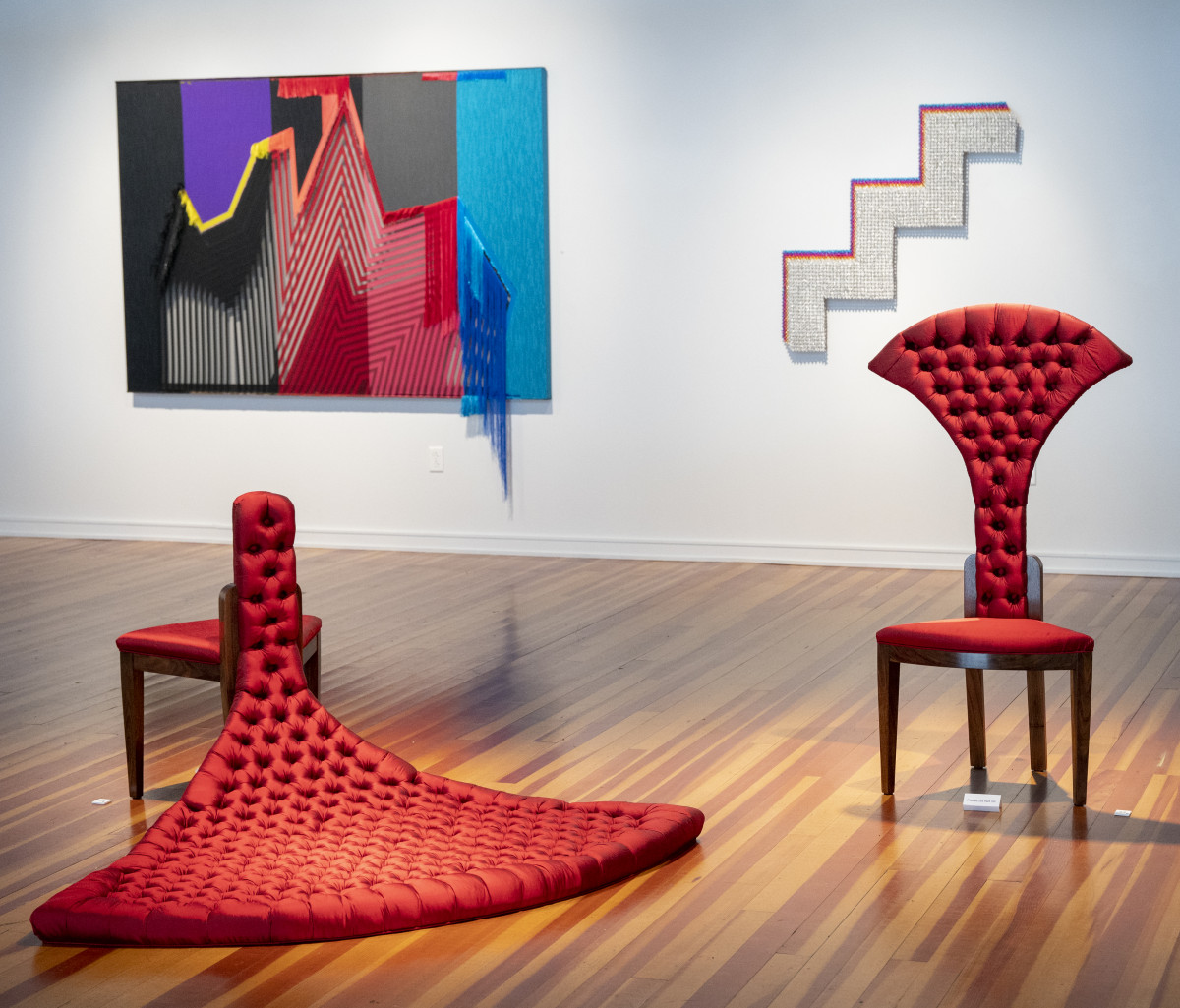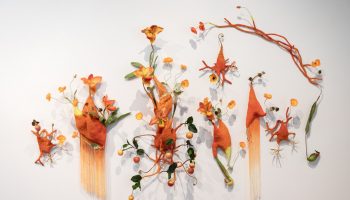JORDYN RUSSELL – STAFF WRITER
Challenging the previous understandings of hard edges and soft curves and building upon the unconventional artistic possibilities at hand, “Counterbalance,” which opened June 27, will be displayed in the Main Gallery of the Strohl Art Center until July 25.
“Counterbalance” features the works of artists Liz Collins, Kelly Dzioba, Annie Evelyn, Phoebe Kuo, Heather MacKenzie, Na Chainkua Reindorf and Ruby Troup — all women working primarily in the media of wood and textiles, using a hybridized language of adornment and structure. These professional and emerging artists use wood objects to drape over corners and conform to the body, while textiles muscle in with bold color and rigid form. Curated by Erika Diamond, assistant director of Chautauqua Visual Arts Galleries, these works of art scale the walls and shimmer from across the room of the Main Gallery.
“The title, ‘Counterbalance,’ is both the curatorial strategy and a nod to a type of weaving loom as the exhibition was previously intended to be a weaving exhibition, (growing) into a more complex dialogue about material language,” Diamond said. “The assertive geometric forms of these textiles counterbalance the empathetic design and organic fluidity found in the wood works, countering our preconceived notions about how these materials should act.”
Liz Collins, who first inspired Diamond in her curation of the exhibition, uses her vibrant woven work that is both engineered and hand-manipulated, both painting and textile, to work fluidly between art and design. Speaking with Caroline Kipp of the “Social Distancing Studio Visits” series, Brooklyn-based Collins explained the captivating process behind her works of art.
“I am an artist that uses textile and fiber in conjunction with hard materials (metal and wood) and other media (video, furniture) to build artworks that range from small needlepoints, to multi-room immersive installations,” Collins said. “My ideas are informed by historical art and design movements such as Op and Pop Art, Arte Povera, Surrealism and Memphis Design, as well as nature and spirit, and infused with my own queer and feminist sensibilities.”
Phoebe Kuo, a studio woodworker who also has pieces displayed in “Counterbalance,” specializes in making “site-specific sculptures using traditional furniture making techniques,” according to her website. San Francisco-based Kuo states that from a young age, she “grew up navigating hybrid identities, which she continues to explore as a queer artist of color.”
“I love the way that Phoebe Quo’s work relates to the work of Liz Collins, stretching from wall to wall and from panel to panel,” Diamond said. “This relationship (between these two individuals) inspired the rest of the exhibition.”
Annie Evelyn, a Rhode Island School of Design alumni, will also have her work featured in this exhibition. Evelyn serves as a co-founder of Crafting the Future, a collective of artists working together to provide equitable opportunities in the arts.
“I want people to recognize that Annie creates every aspect of her artwork on her own; for example, with this piece of furniture, she did all of the woodworking and the upholstery herself,” Diamond said.
“Joy, laughter and the unexpected are at the heart of (my) work,” Evelyn wrote on her website. She also employs a range of materials, ranging from handmade paper flowers to Swarovski crystals.
Additionally, Evelyn uses “furniture’s inherent interactive qualities and relationships to the human body” to create new experiences.
“Heather Mackenzie’s work is also very interesting as it is worked out using platonic mathematics, but also exemplifies cleverness — even though it is actually quite deceptively simple,” Diamond said. “She combines technology and hand-weaving but also incorporates supplemental warp as well.”
Mackenzie has studied traditional textiles all over the world, in locations such as Ecuador, Europe, India, Zimbabwe and Ghana.
Na Chainkua Reindorf is Ghanaian-born and also resides at the intersection of cultural and historical textiles. On her website, Reindorf wrote this is where “relatively commonplace objects such as scraps, threads and patterns merge to create something meaningful.”
“When choosing the artists for the exhibition, the bigger picture was to support and display females in woodworking, as well as queer women, while simultaneously also considering textile function and history,” Diamond said. “We also tried to push boundaries with the works of art on display, featuring pieces that could be used in conversation, made by artists of various different backgrounds.”
Ruby Troup, a New Mexico-based artist specializing in cabinet-like compositions, agreed with Diamond’s statement regarding the conversational qualities that art can provide to an audience.
“When I look at the things that I make, I can sort of read them like a book of my experiences, in a way, with a bunch of small pieces that relate to the greater narrative of the piece,” Troup said. “At the same time, as my work is autobiographical, it is very important to me that people can form their own conversations and connections with the pieces. Although the artwork is based on my narrative and the narratives of my fellow artists, I want the viewers to leave being able to truly place themselves inside and forge their own narrative.”








